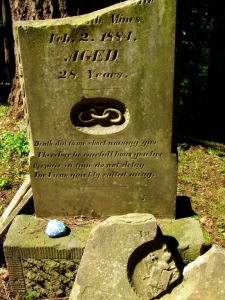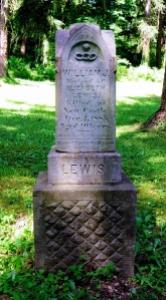Newcastle Cemetery headstones bluntly attest to the difficult mining life and temporary respite offered by various brotherhood communities. Thanks to the ring of trees protecting the site, most of the carvings have escaped the inevitable Pacific Northwest erosion.
William T. Scott’s stone is one such survivor.
“Death to me short warning give, Therefore, be carefull how you live. Prepare in time and do not delay, For I was quickly called away…”
Scott’s membership in both the International Order of Odd Fellows (IOOF) and the Knights of Pythias, is also clearly marked. The Odd Fellows are denoted by the three chain links signifying friendship, love, and truth…
…while an intricately carved knight’s head, ax, open book, and drawn sword, mark the Knights of Pythias membership. The carving is also surrounded by a triangle carved with the initials F, B, and C – representing friendship, benevolence, and charity.
Founded in 1864, the Knights of Pythias was the first Congressionally-chartered brotherhood. It was based on the ancient Greek legend of Damon and Pythias.
“Once upon a time, there were two men called Damon and Pythias who had been good friends from childhood. As adults, Pythias had a steady, easy-going temperament while Damon grew up to be an impulsive hothead, often speaking his mind before considering the consequences. One day, he went too far and insulted the king.
The consequences were severe: he was imprisoned and sentenced to death.
Wanting to say goodbye to his wife before he died, Damon requested permission to travel home. He promised to return and as a gesture of good faith, his friend Pythias stepped in as collateral. The king agreed to the deal but reminded Damon that if he failed to return, Pythias would find no mercy on the executioner’s block.
As luck would have it, Damon was delayed and the king held true to his promise.
Pythias was led into the crowded execution area and prepared for death. At the very last minute, Damon arrived. He rushed to the execution block, pushed Pythias aside, and stood ready to face his punishment.
The king was so impressed at this display of true friendship and loyalty, he freed them both.”
James Murphy was another dual Odd Fellows/Knights of Pythias member, but his stone is carved differently.
The top of the stone has an open book, representing what Murphy accomplished (or didn’t) in his life. The front panel shows his two brotherhood memberships and above them, perhaps, his Irish outlook.
The curtains of life are drawn aside to show the sun rising on a bright new day.
“May the road rise to meet you, may the wind be always at your back. May the sun shine warm upon your face, the rains fall soft upon your fields….”
Another Odd Fellow brotherhood example includes the Lewis memorial. Like William Scott’s stone, there is a very realistic, 3-D chain link carving below what appears to be an eye. And like Scott, Lewis also died tragically after a coal car broke loose and crushed him to death in the mines.
The final story involves the Sparling family plot, a plain little stone, and an intriguing, colorful blanket.
Doc Sparling was a well-known Newcastle doctor and this particular marker commemorates his child who died shortly after being born. The small marker stood undisturbed for many years before it disappeared. No one ever discovered what had happened and eventually, it was chalked up as just another unfortunate cemetery theft.
Fast forward several decades.
Some local hikers were scrambling around the old railroad tracks when one of them saw something white gleaming beneath a pile of leaves and slag. It turned out to be a headstone. Further investigation confirmed it was the long-lost Sparling baby headstone. The marker, wrapped in a colorful baby’s blanket, was soon returned to its rightful place in the Newcastle cemetery.
Yet for all its history and carvings, the cemetery rarely gets visitors.
One reason is more practicality than anything else. The cemetery is now closed to the public (thanks to repeated vandalism) except on certain local and federal holidays. Another reason is fading interest. Families move away and subsequent generations lose interest.
When asked about this, Milt Swanson observed that it’s simply the way life happens.
The first generation included the workers, the miners, and their families. All too often, the cemetery had a brutally direct connection. As a result, the second generation wanted a separate direction, an escape from the vivid, soot-filled mining past.
Attention dwindled and the cemetery languished.
The third generation was different. Having grown up in more comfortable circumstances, they saw their grandparents’ efforts through a different perspective, recognizing family connections to a unique local history. They sought to revive this awareness through improved maintenance and cemetery preservation.
But grandparents pass away and the memories are forgotten. With few remaining direct links to the past, the cemetery stories have faded into little more than anecdotes in a grade school history book.
A sincere thanks to local photographer, Bob Cerelli, for providing the photo samples for both Part I and Part II






Would African-American coal miners be buried in this cemetery? I am trying to locate my great grandfather, John Peters or Peterson.
Thank you
I was the one that took most of the photographs of the cemetery. I did not see your relative there
I would get a list from the cemetery of the buried people there. In public records somewhere? When I use to visit…the gravesites were pretty old and no one had been buried there for quite sometime…most people in the area were buried at the Highlands Cemetery…I would check there. Vandalism was evident even in the 60’s….no caretaker to watch over…we called it the pioneer’s cemetery.